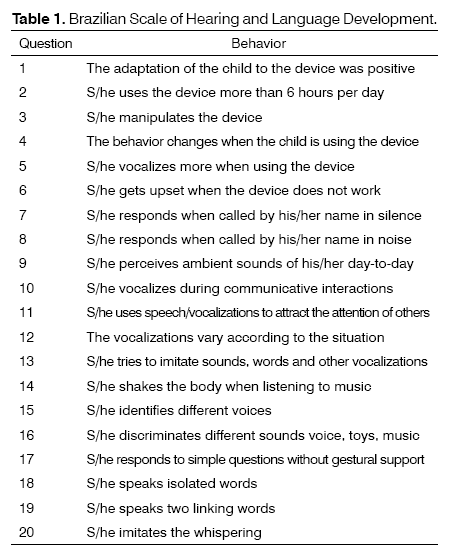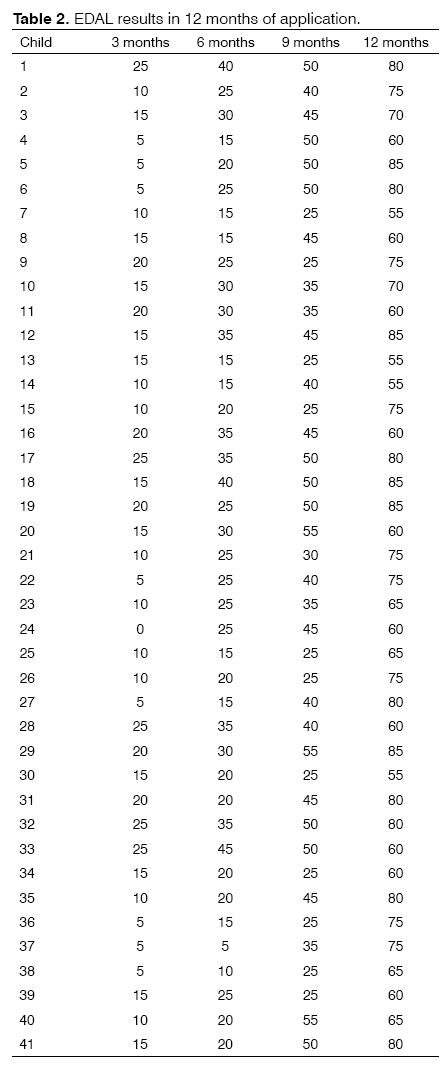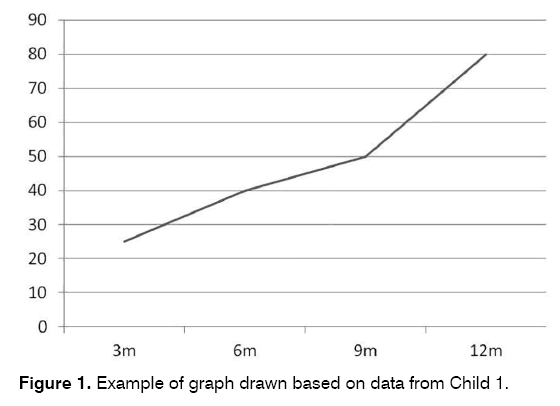The International Tinnitus Journal
Official Journal of the Neurootological and Equilibriometric Society
Official Journal of the Brazil Federal District Otorhinolaryngologist Society
ISSN: 0946-5448

Google scholar citation report
Citations : 12717
The International Tinnitus Journal received 12717 citations as per google scholar report
The International Tinnitus Journal peer review process verified at publons
Indexed In
- Excerpta Medica
- Scimago
- SCOPUS
- Publons
- EMBASE
- Google Scholar
- Euro Pub
- CAS Source Index (CASSI)
- Index Medicus
- Medline
- PubMed
- UGC
- EBSCO
Volume 20, Issue 1 / June 2016
Research Article Pages:7-10
10.5935/0946-5448.20160002
Brazilian scale of hearing and language development in children (EDAL-1) with cochlear implant and less than two years of hearing AGE
Authors: Angela Ribas1 and Ana Paula Kochen2
PDF
Abstract
Objective: To present the protocol called the Brazilian Scale of Hearing and Language Development.
Materials and Methods: This is a protocol developed in order to assess and record the development of hearing and language skills in young children who have undergone cochlear implantation during the first two years of hearing age. It was applied to the parents of 41 children over a period of 12 months at the cochlear implant clinic in the Pequeno Príncipe Hospital in Curitiba, Brazil.
Registered were: the time taken to implement the protocol; ease of understanding the questions; numerical results obtained by the children evaluated.
Results: In general, the questions were considered easy to understand. The minimum time taken for application of the protocol was two minutes and the maximum was 11 minutes. At the end of the evaluation, it was possible to quantify the development in 100% of the cases.
Conclusion: EDAL proved an agile, quick and easy, instrument to be used in the first two years of hearing age.
Keywords: deafness, speech therapy, cochlear implantation, child.
Introduction
Cochlear implants (CI) are currently the most effective technological resource to facilitate access for deaf people to the hearing world [1]. Their use, especially when implanted early in children, reduces the impact of deafness on hearing as well as spoken language development.
Due to constant technical and scientific developments in the area, children under 12 months of age are currently implanted all over the world, giving this population the ability to broadly develop their skills more equally, with few gaps, compared to their hearing peers [2,3]. Assessment of the auditory and language skills for these children through standardized tests is important because the systematic documentation and analysis of the child’s development allows a proper guide for the family and subsidizes therapeutic conduct [4-7]. However, assessing young children, with less than two years of age, it is not an easy task [8], especially because the evaluation of auditory and language skills is subjective and depends on a rated response. This observation was found in the CI clinic at the Pequeno Principe Hospital (HPP), located in Curitiba, Brazil, where this research was conducted.
HPP was accredited by the Ministry of Health (SUS) as a benchmark service in performing CI in 2010. It is a pediatric hospital that evaluates, diagnoses, implements, rehabilitates and monitors deaf children.
Besides the pre-surgical evaluation and procedures performed during surgery (impedance measurements and neurotelemetry), speech therapists at HPP periodically perform device adjustments and check the development of the child, in order to guide the family, rehabilitative audiologist, and school. This reality shows the need to develop a simple and easy protocol to be applied, that would allow the child’s performance to be compared to his/ her own past performance, to the performance of other deaf children, and to the performance of his/ her hearing peers.
Thus, the purpose of this article is to present the protocol called the Brazilian Scale of Hearing and Language Development (EDAL-1) and its preliminary results.
Materials and Methods
This is an experimental cohort study, approved by the Institutional Ethics Committee under number HPP1069241-2015.
The participants were 41 parents/guardians of implanted children at HPP between 2011 and May 2015, who completed the EDAL-1 evaluation (Table 1).
29 mothers, 8 fathers and 4 grandparents were interviewed. The minimum age of the sample was 23 years old and the maximum was 54. All respondents were responsible for the education of the implanted child, agreed to participate, signed the consent form and participated in the four interviews.
EDAL-1 is an interview-based protocol given to parents or guardians of the implanted child during the consultations for CI regulation during the first two years of hearing age. It consists of 20 questions whose answers can be YES or NO. Each positive answer is worth five points. At the end of the application, the audiologist multiplies the number of YES answers by 5 to obtain the overall score, which can range from zero to 100.
The protocol aims to objectively, clearly and quickly investigate whether the child, from CI activation has developed a connection with the device (questions 1, 2, 3, 4 and 6), turned his attention to the world of sound (questions 7, 8 and 9), attributed meaning to sounds (questions 14, 15, 16 and 17) and demonstrated intentional speech communication (5, 10, 11, 12, 13, 18, 19 and 20).
Parents were interviewed three months after activation of the CI, and in subsequent quarterly consultations, which are aimed at monitoring and regulating the device for 12 months.
During the application of EDAL-1, the following variables were assessed: the time taken to implement the protocol; ease of understanding the questions; numerical results for the evaluated children.
To check the time needed for giving the evaluation, a simple timer was used, by being turned on at the beginning of the interview and off the end of it.
To check the ease of understanding the protocol, after completing the EDAL-1, respondents were asked to identify on a visual analogue scale one of five options: 1) very easy to answer, 2) easy to answer, 3) difficult to answer, 4) very difficult to answer, 5) not sure.
Finally, the results of each child were compared in subsequent sessions and presented to respondents to verify the evolution in terms of hearing and language.
Results
The protocol response time ranged from 2.30 to 11.30 minutes (mean 4.28 minutes).
When asked about the level of difficulty encountered in answering the protocol, 29 subjects (70%) reported that it was easy to understand and 12 (30%) said it was very easy.
The results obtained in EDAL-1, per child, are presented in Table 2. For each child evaluated, it was possible to draw a graph (Figure 1), delivered to each family at the end of the evaluations, which demonstrated to parents and guardians the progress achieved.
Discussion
Generally, the EDAL-1 was considered easy to understand by the respondents and the time required for response was short. This data allows us to infer that it can be used in routine care, without requiring large amounts of clinical time or additional explanations. In hearing health for the national healthcare system, demand for follow-up visits is growing exponentially in Brazil [9] and the use of agile and fast assessment protocols to complement hearing and language evaluations in audiology in the realm of the therapeutic clinic is required.
Deaf children implanted at HPP undergo speech therapy in their city of origin. Therapeutic speech-language pathologists should turn in a report, to health services, at the time of adjustment of the CI. Such a report should describe the type of intervention and the current hearing and language conditions of the child being evaluated, and the report should regulate the device setting process. Given the difficulties inherent in evaluation of children [8], involving the family in this investigative process is fundamental [10]. The EDAL-1 was effective in this regard because the answers offered by parents and guardians interviewed were consistent and allowed verification of if the child was creating links with the CI, was aware of sounds in the world, gave meaning to sounds, and demonstrated communicative intentions.
The effectiveness of the CI to reduce the impact of hearing loss on the development of hearing, and hence of oral language, particularly in children implanted early, has already been proven [11]. It is important to periodically assess the development of hearing and language skills in these children, and use protocols that enable the systematic documentation and analysis of the child’s development in order to offer solutions for therapeutic management. The EDAL-1 was effective with regard to the follow-up of the studied children. From the data recorded in interviews with parents, it was possible to draw each child’s developmental pipeline and thus establish the progress made from the day of activation.
During the application of EDAL-1, respondents had the opportunity to see the advances made possible by the CI and ask questions regarding the development of children. Some participants noted that advances presented as a graph, which they took home to share with other relatives, motivating the desire for continuity. This fact agrees with research showing how important family involvement is in the rehabilitation process for implanted patients [12,13].
Further studies with the protocol are under development in the Graduate Program in Communication Disorders at the University of Tuiuti, in association with CI service at HPP, with a view to: define the protocol’s level of reliability and sensitivity; conduct performance comparisons between deaf and hearing children; make comparisons between deaf children implanted earlier and later in age; associate the application of EDAL-1 to other instruments in the area.
Conclusion
The EDAL-1 proved to be a responsive instrument that was easy and quick to use for evaluation and follow-up of implanted children during the first two years of hearing age.
References
- Melo TM, Lara JD. Habilidades auditivas e linguísticas iniciais em crianças usuárias de implante coclear. J Soc Bras Fonoaudiol. 2012;24(4):390-4.
- Calháu CM, Júnior LR, Reis AM, Capistrano AK, Lima DV, Calháu AC, et al. Etiology profile of the patients implanted in the cochlear implant program. Braz J Otorhinolaryngol. 2011;77(1):13-8.
- Harrison RV, Gordon KA, Mount RJ. Is there a critical period for cochlear implantation in congenitally deaf children? Analyses of hearing and speech perception performance after implantation. Develop Psychobiol. 2005;46(3):252-61.
- Mylanus E, Vermeulen A, Neijenhuis K, Snik A. Auditory and language assessment tools in pediatric cochlear implant patients: a followup study. In: Abstracts of the 8ª European Symposium Pediatric Cochlear Implants; 2006 Mar 25-28; Venezia; 2006. p.106
- Moret ALM, Ficker LB, Martinez MANS. Fórum de (Re)habilitação auditiva: XV Encontro Internacional de Audiologia. Dist Comun. 2000;11(2):339-48.
- Nikolopoulos TP, Archbold SM, Gregory S. Young deaf children with hearing aids or cochlear implants: early assessment package for monitoring progress. Int J Pediatr. Otorhinolaryngol. 2005;69(2):175-86.
- Donaldson GS, Dawson PK, Borden LZ. Within-subjects comparison of the HiRes and Fidelity120 speech processing strategies: speech perception and its relation to place-pitch sensitivity. Ear Hear. 2011;32(2):238-50.
- Schramm B, Bohnert A, Keilmann A. Auditory, speech and language development in young children with cochlear implants compared with children with normal hearing. Int J Pediatr Otorhinolaryngol. 2010;74(7):812-9.
- Dumke C, Ribas A, Gonçalves CGO, Martins J, Malucelli D. Investigation of verified technical failures in hearing aids for users of a public hearing health program. Rev CEFAC. 2014;16(4):1117-24.
- Fitzpatrick EM, Jacques J, Neuss D. Parental perspectives on decision-making and outcomes in pediatric bilateral cochlear implantation. Int J Audiol. 2011;50(10):679-87.
- Fortunato CAU, Bevilacqua MC, Costa MPR. Comparative of verbal language analysis of listeners children and deaf children with cochlear implant. Rev CEFAC. 2009;11(4):662-72.
- Hyde M, Punch R, Komesaroff L. Coming to a decision about cochlear implantation: parents making choices for their deaf children. J Deaf Stud Deaf Educ. 2010;15(2):162-78.
- Miziara ID, Miziara CSMG, Tsuji RK, Bento RF. Bioethics and medical/legal considerations on cochlear implants in children. Braz J Otorhinolaryngol. 2012;78(3):70-9.
References
1Fonoaudiologia - Universidade Tuiuti do Paraná, Curitiba, PR, Brazil. E-mail: angela.ribas@utp.br
2Fonoaudióloga - Reabilitare, Curitiba, PR, Brazil. E-mail: anapaulakochen@hotmail.com
Institution: Universidade Tuiuti do Paraná and Hospital Pequeno Príncipe
Send correspondence to:
Angela Ribas
Rua José Isidoro BIazetto
845 ap. 501. Curitiba, PR, Brazil. CEP: 81200-240
E-mail: angela.ribas@utp.br
Paper submitted to the RBCMS-SGP (Publishing Management System) on February 01, 2016; and accepted on May 31, 2016. cod. 221
Citation: Ribas A, Kochen AP. Brazilian scale of hearing and language development in children (EDAL-1) with cochlear implant and less than two years of hearing AGE. Int Tinnitus J. 2016;20(1):7-10.





